Color Temperature
Photomicrography - Color Temperature
The concept of color temperature is based on the relationship between the temperature and radiation emitted by a theoretical standardized material termed a black body radiator cooled down to a state in which all molecular motion has ceased. Hypothetically, at cessation of all molecular motion, the temperature is described being at absolute zero or 0 Kelvin, which is equal to -273 degrees Centigrade.
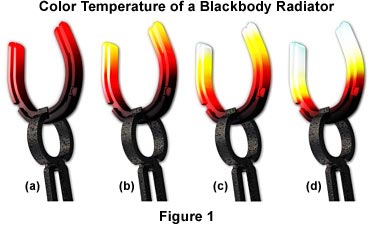
Imagine now that the black body radiator is heated to the temperature of freezing water, equal to 273 Kelvin, 0 degrees Centigrade, or 32 degrees Fahrenheit. The black body is then further heated to the temperature of boiling water: 373 Kelvin, 100 degrees Centigrade, or 212 degrees Fahrenheit. If the black body continues to be heated, it will begin to glow and give off its own light. When the temperature reaches 3200 Kelvin, the radiator will be emitting light with a visible spectrum equal to the color temperature of light produced by a tungsten filament, typical of those found in microscope lamps.
The absolute temperature of a black body radiator is always expressed in Kelvin, which is equivalent (the degree increments are identical) to degrees Centigrade (°C) plus 273 degrees. For example, 1000 K equals 727 °C. Therefore, we can define the color temperature of a light source as the value of the absolute temperature of a black body radiator when the radiator chromaticity matches that of the light source. In the case of fluorescent lamps and other sources that can only approximate the chromaticity of a black body, the corrected term correlated color temperature is applied through a calculated chromaticity.
Although this black body radiator does not actually exist, many metals behave in a similar manner, so we can employ a black metal horseshoe (Figure 1) as an example for this discussion. In Figure 1, the horseshoe is first heated to a temperature of about 900 K (Figure 1(a)), where it begins to glow a dull red. As the temperature is increased to between 1500 K and 2000 K, the horseshoe (Figure 1(b)) turns a yellowish to brighter red color. Increasing the temperature still further to just over 3000 K produces a yellow-to-white color transition (the color temperature of a tungsten filament, Figure 1(c)), and at 5000 K and above (the color temperature of daylight, Figure 1(d)), a bluish-white color appears. This concept can be further investigated in our interactive Java-powered color temperature tutorial linked below.
The concept of color temperature is very important in photography, where film emulsions must be balanced to accurately render color using different light sources. This is especially true in photography through the microscope. Films intended to be used outside in ordinary daylight, or indoors with fluorescent or flash lighting, are balanced during manufacture for a color temperature of 5500 K. Alternatively, films designed for use indoors with tungsten light bulbs (or in the microscope) are balanced for a color temperature of 3200 K to 3400 K. The 5500 K average value of the daylight color spectrum varies during different parts of the day and is also season-dependent (see Table 1). In the early morning and late evening, the color temperature will fall to 5000 K and below, causing color shifts in the emulsion that result in warmer (redder) color renditions.
There are two important points to consider when examining color temperature phenomena. The color temperature value of a light source refers only to the visual appearance of the source, but does not necessarily describe the effect this source will have on photographs or photomicrographs. Also, color temperature does not take into consideration the spectral distribution of a visible light source. In cases where a light source, such as a fluorescent lamp, laser, or gas lamp, does not have a spectral distribution similar to that of a black body radiator, its color temperature alone is not a reliable means of selecting suitable filters for color balance corrections. Therefore, although two different light sources may be described as having the same color temperature, exposed photographic emulsions may respond differently to the sources. When using fluorescent lamps or similar light sources, a per-wavelength comparison of film sensitivity and spectral output is necessary to determine the correct filters for color temperature balance.
Accepted convention for evaluation of light sources, in regards to filter requirements for color balance adjustment, utilizes the reciprocal of the color temperature, which is referred to as microreciprocal degrees or mireds, when multiplied by one million. This approach is useful because a given sum of reciprocal units corresponds approximately to the same color difference for most light sources that emit a visible spectrum (in the range from 1000 K to 10,000 K). For instance, a color conversion filter that produces a 100 K color temperature decrease in a 3200 K light source will produce a decrease of about 1000 K in a 10,000 K light source. Converting these values to mireds:
(1/3200 K) × 1,000,000 = 313 mireds
(1/3100 K) × 1,000,000 = 323 mireds
323 mireds (3100 K) - 313 mireds (3200 K) = 10 mireds
and
(1/10,000 K) × 1,000,000 = 100 mireds
(1/9000 K) × 1,000,000 = 111 mireds
111 mireds (9000 K) - 100 mireds (10,000 K) = 11 mireds
It is apparent that although the degree differential between conversion of the 10,000 K and 3200 K light sources is 1000 K and 100 K respectively, the actual filtration difference is virtually the same when compared as mired units (10 versus 11 mireds).
Recently, the term reciprocal megakelvins (1/MK) has been used by Kodak and others to replace mireds. The reciprocal color temperature expressed in reciprocal megakelvins has the same value as mireds, but the value is determined by first expressing the color temperature in megakelvins (1 MK = 1,000,000 K) and taking the reciprocal. For example, a 5500 K light source can be represented as:
0.0055 MK
Taking the reciprocal:
1/0.0055 MK = 182 MK-1 = 182 Mireds
Filters designed to modify the effective color temperature of a light source can be defined in terms of their reciprocal shift value defined by the expression:
Reciprocal Shift Value = 1/T(2) - 1/T(1)
Where T(2) is the color temperature of light that has passed through the color balance filter and T(1) is the color temperature of the original light source. For example, if the color temperature of a microscope tungsten-halogen lamp is to be corrected for daylight-balanced film, the equation to calculate the reciprocal shift value would be:
1/0.0055 - 1/0.0032 = 182 - 313 = -131 MK-1
In this example, the reciprocal shift value is -131 MK-1. Notice that the sign of the reciprocal shift value is negative, which occurs when a conversion or balancing filter raises the color temperature of a light source. Conversely, when a conversion or balancing filter lowers the color temperature of a light source, the reciprocal shift value is a positive number.
Almost all indoor/tungsten films have been designed to respond with the correct color balance when illuminated by light having a color temperature of 3200 K. Under these circumstances, colors on the film will match those of the observed image. These films are referred to as type B indoor films and include the Ektachrome and Fujichrome tungsten-balanced films. Type A indoor films respond to the slightly higher color temperature of 3400 K, and include tungsten-balanced Kodachrome 40T as an example of this type of film. A color temperature of approximately 5500 K is required to match the color-balance design of all outdoor or daylight film.
One of the primary tasks in photomicrography is ensuring that the color temperature of light reaching the film is properly matched to the color temperature for which the color film has been designed. The microscope almost always uses a tungsten, or more likely a tungsten halogen bulb, as the source of light. Most specimens, with the exception of fluorescing specimens, do not emit their own light. Fluorescence equipment may use mercury or xenon burners to excite the specimen to fluoresce, which often requires matching color balance with a daylight type film.
Approximate Color Temperatures of
Common Light Sources
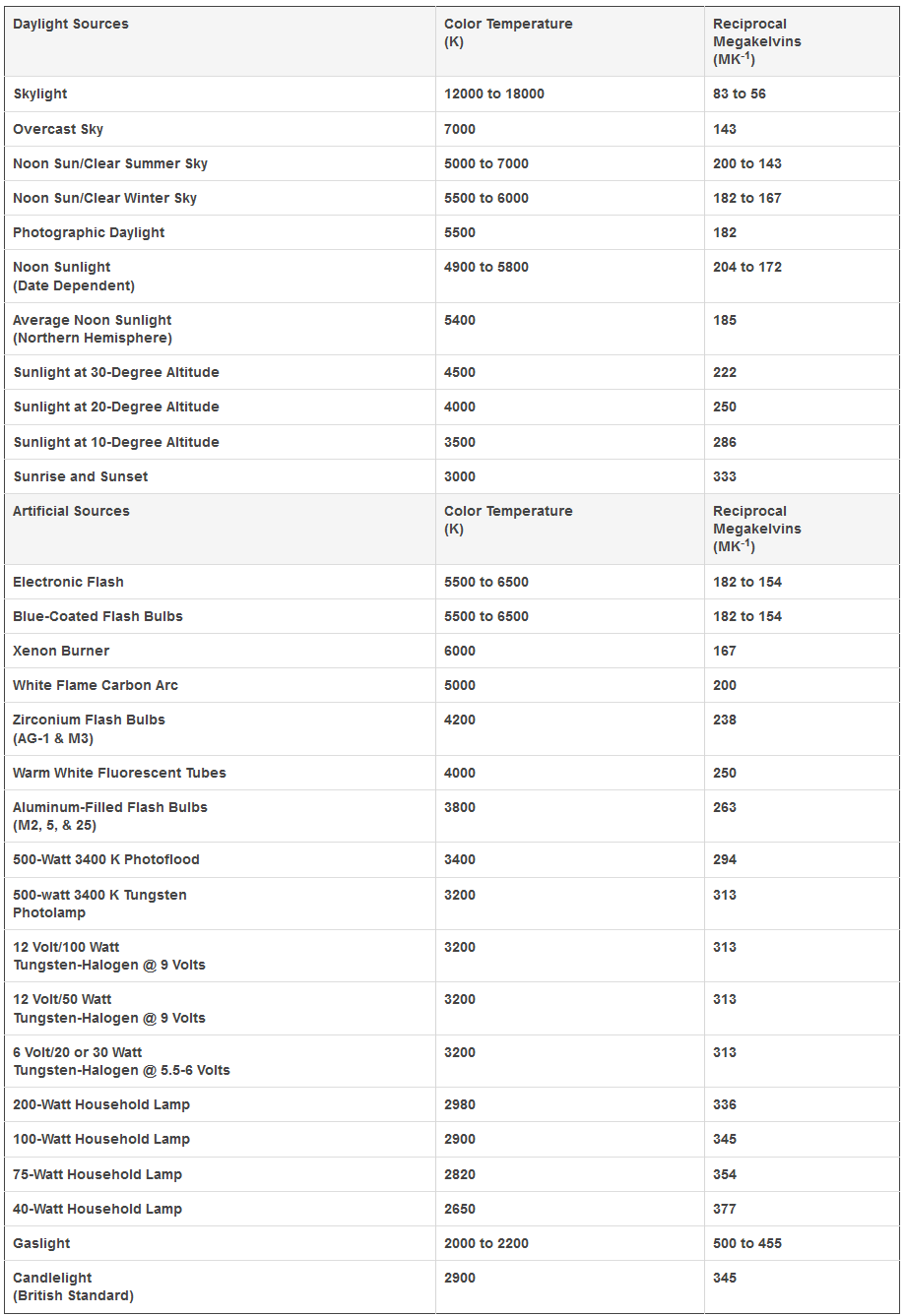
Table 1
How does the microscopist ensure that the color temperature of light reaching the film matches the film's design? The temperature of the light emanating from the heated coil of the halogen bulb is dependent on the voltage sent through the bulb to heat its filament. Tungsten and tungsten-halogen lamps emit a continuous spectrum of energy that is manifested by a relatively constant output for each wavelength (Figure 2). A majority of the energy emitted by these lamps is in the long wavelength part of the spectrum (red and higher), and they subsequently produce a large amount of heat that is not useful for optical microscopy. In fact, about 90 percent of the energy emitted by tungsten and tungsten-halogen lamps is released in the form of infrared radiation and heat. The visible spectrum of a typical tungsten lamp is illustrated in Figure 2 for three color temperatures. Note that the spectral distributions are similar for each color temperature, with the ratio of blue to red increasing as color temperature is increased by raising the voltage applied to the lamp.
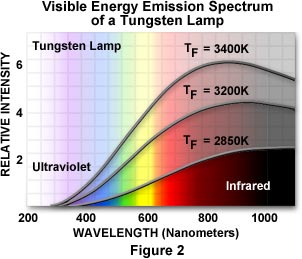
Almost all modern microscopes have a step-down transformer with a voltage regulator built into the base of the microscope. The voltage produced by this transformer is usually controlled by a knob or wheel or a slider positioned on the base or side of the microscope. In many modern microscopes, the voltage is signified by light emitting diodes or a voltmeter directly displaying the voltage. Table 1 shows the color temperature of several common microscope bulbs and a variety of other light sources when set at particular voltages or under natural conditions. The higher the voltage setting of the microscope's step-down transformer, the higher the color temperature of the light emitted. As the voltage is raised, the white light becomes more bluish; as the voltage is reduced, the light becomes more reddish-yellow. Once the voltage for color photomicrography has been correctly set, do not use the voltage regulator to adjust brightness, because such an adjustment will affect the color temperature.
The test of properly balanced light, matched to the film's design, is to have the clear background of a photomicrograph appear white. A bluish background indicates too high a color temperature, while a yellowish background signifies too low a color temperature.
To facilitate the correct setting for photomicrography, many modern microscopes have a photovoltage button that, when pressed, automatically sets the 12 volt 100-watt halogen lamp at 9 volts or the 6 volt 20-watt halogen lamp at 5 to 6 volts to deliver light approximating 3200 Kelvin.
When using black/white films (color temperature is not relevant here), changing the voltage going to the microscope lamp will change the intensity of the light. Raising the voltage in this instance will increase intensity and shorten exposure, whereas lowering the voltage will reduce intensity and result in longer exposures.
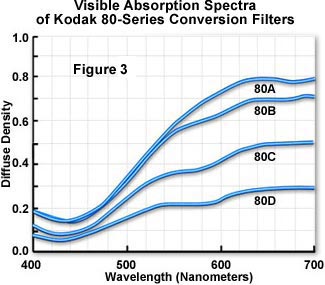
While the most common bulbs (12 volt, 100-watt halogen; or 6 volt 20-watt or 30-watt halogen) can be set to yield a color temperature close to 3200 Kelvin (to match the color balance of indoor Type B films), none of these bulbs (except the xenon burner) can radiate light suitable for daylight balanced films. In order to produce light simulating daylight quality, a color conversion filter must be placed in the light path, either on the light port of the microscope or in a built-in holder. The most common conversion filter (producing big jumps in color temperature) is the Kodak 80A filter (3200 Kelvin to 5500 Kelvin) or its relatives 80B, 80C, 80D (see Table 2 and Figure 3). For Olympus microscopes, the equivalent daylight-balanced filter is called the LBD filter, and for Nikon microscopes the filter is termed the NCB filter. The visible absorption spectra for the Kodak 80-series conversion filters are illustrated in Figure 3. These filters display an absorption maximum centered in the 600-650 region of the visible spectrum, which includes most of the yellow and red wavelengths. The 80A filter has the highest extinction coefficient and thus, by absorbing more red and yellow light, will produce the greatest shift in effective color temperature (see Table 2) followed by the 80B, 80C, and 80D.
Color Temperature Conversion Calculator
Use our color temperature conversion calculator to determine the appropriate filters for converting microscope illumination from one color temperature to another. Simply choose the starting color temperature and the desired final color temperature from the pull-down menus, and our interactive Java calculator will automatically perform the calculation.
For small increases in color temperature, the light blue Kodak 82-series filters (Table 2) can be used. Conversely, for small drops in color temperature, the light yellow Kodak 81-series filters are used (Table 2 and Figure 5). When attempting to convert the color temperature of a daylight-balanced microscope light source such as a xenon lamp or flash tube for use with tungsten-balanced color film, use the amber Kodak 85-series filters. Although it is far more practical to utilize a microscope equipped with a tungsten-halogen light source, especially for critical photomicrography, these filters will serve in cases where it is impossible to use other lamps.
Exposure Compensation with Color Conversion and Balancing Filters
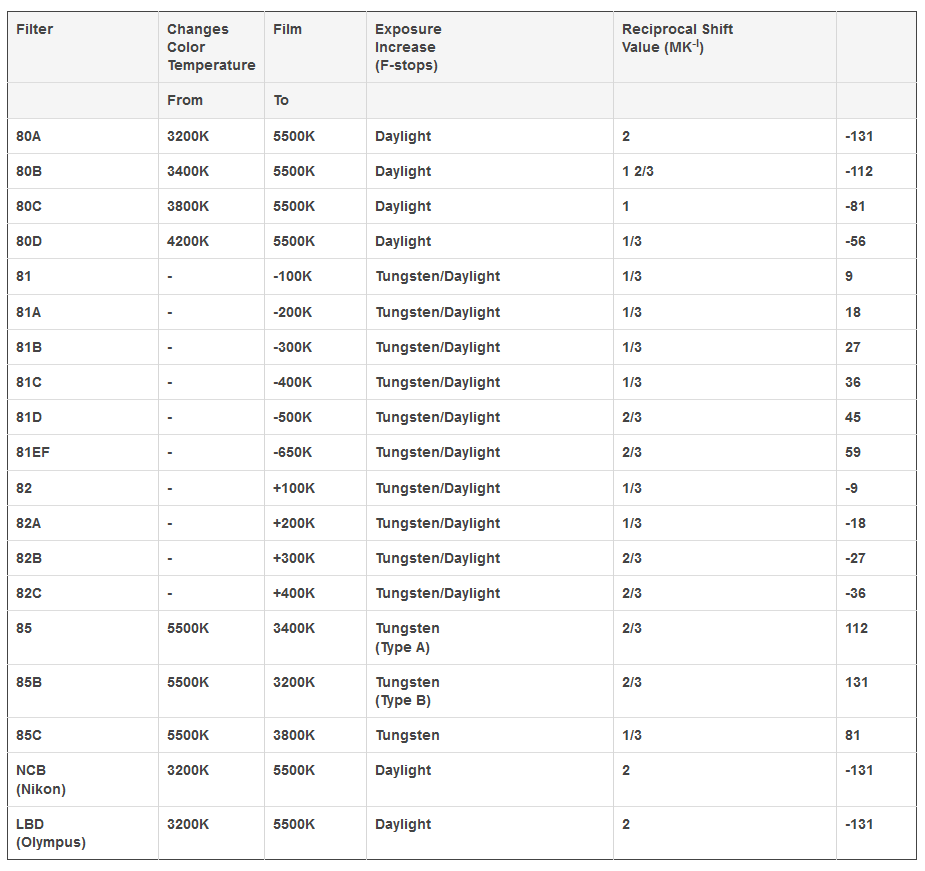
Table 2
These "fine tuning" filters (Kodak series 81, 82 and similar filters) useful for making smaller adjustments (100 k to 600 K) to color temperature are called color balancing filters as opposed to color conversion filters that produce large changes (several thousand kelvins) in color temperature. The values listed in Table 2 can be used as a guideline to demonstrate the effect of color balancing and conversion filters when placed in the light path. The nomograph illustrated in Figure 4 can also be used to determine the appropriate filter to be chosen to go from a known starting color temperature to the desired color temperature. To use this graph, place a straight edge ruler connecting the color temperature of the original source to that of the converted source. The point crossed on the central axis by the ruler identifies the necessary filter to achieve the color conversion. A more convenient method of determining the necessary color temperature conversion filter for color balance adjustment employs our Color Temperature Conversion Calculator, which calculates the appropriate filter when the proper starting and final color temperatures are selected from a pull-down menu.
Sorry, this page is not
available in your country.
